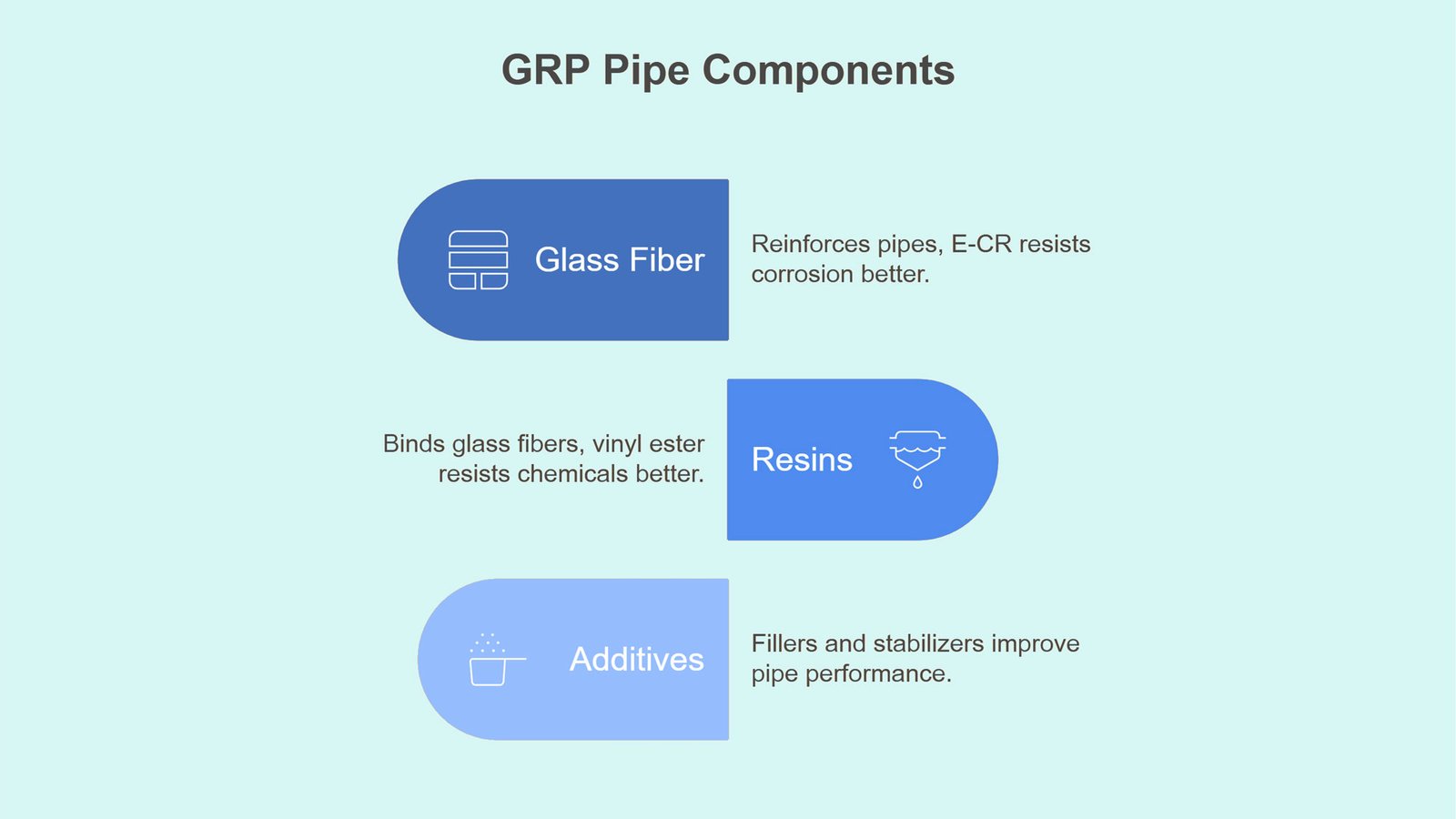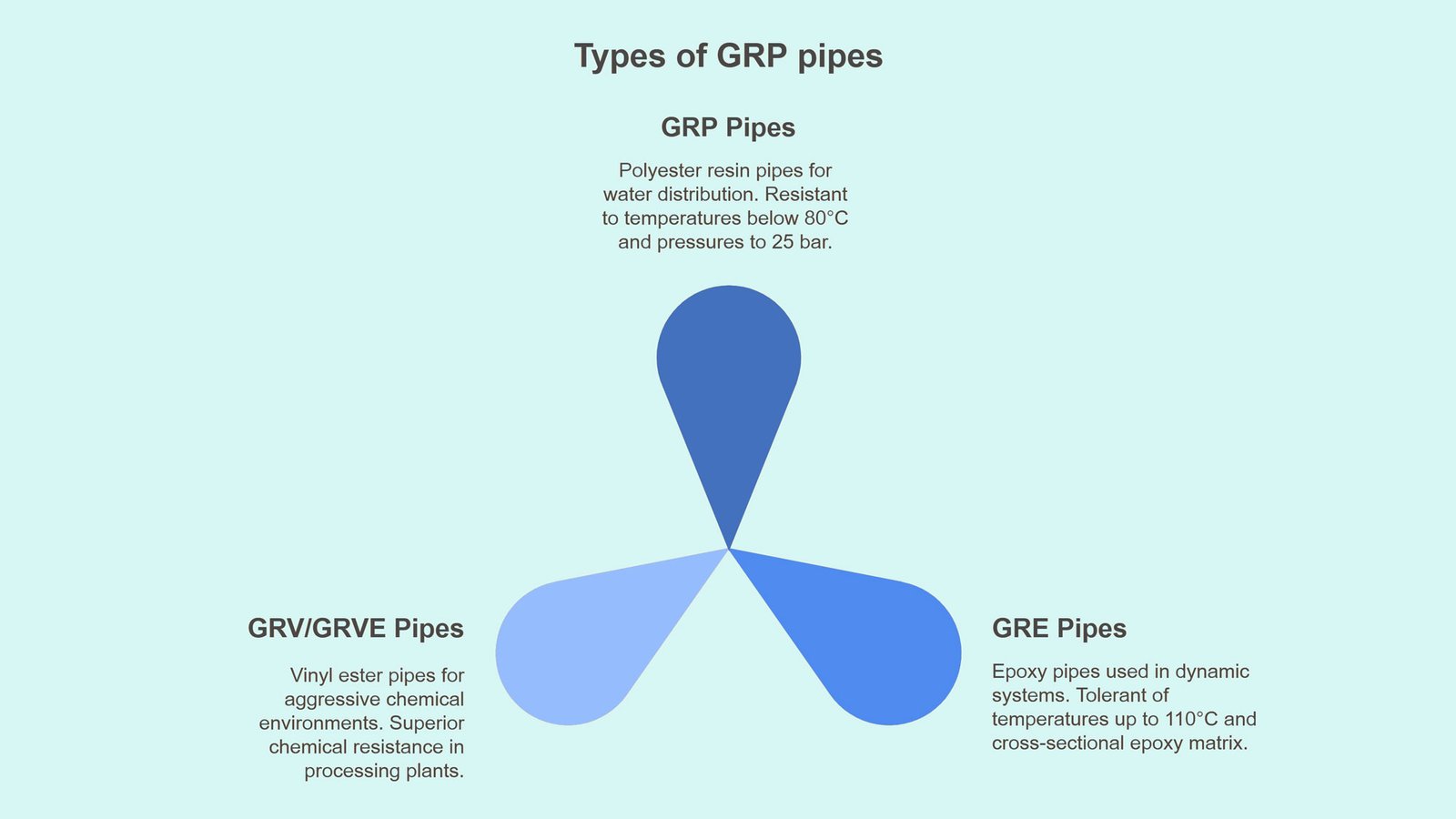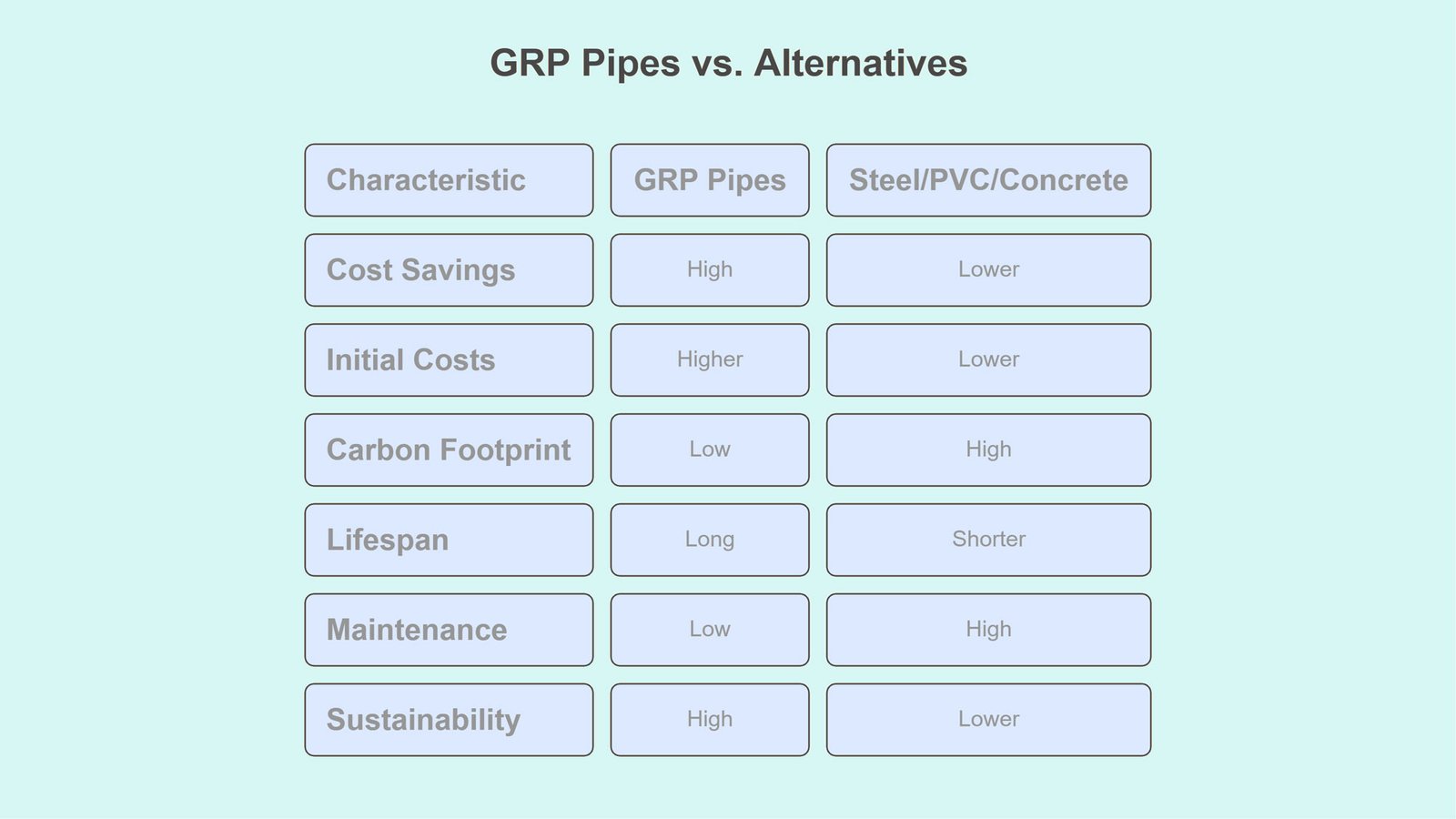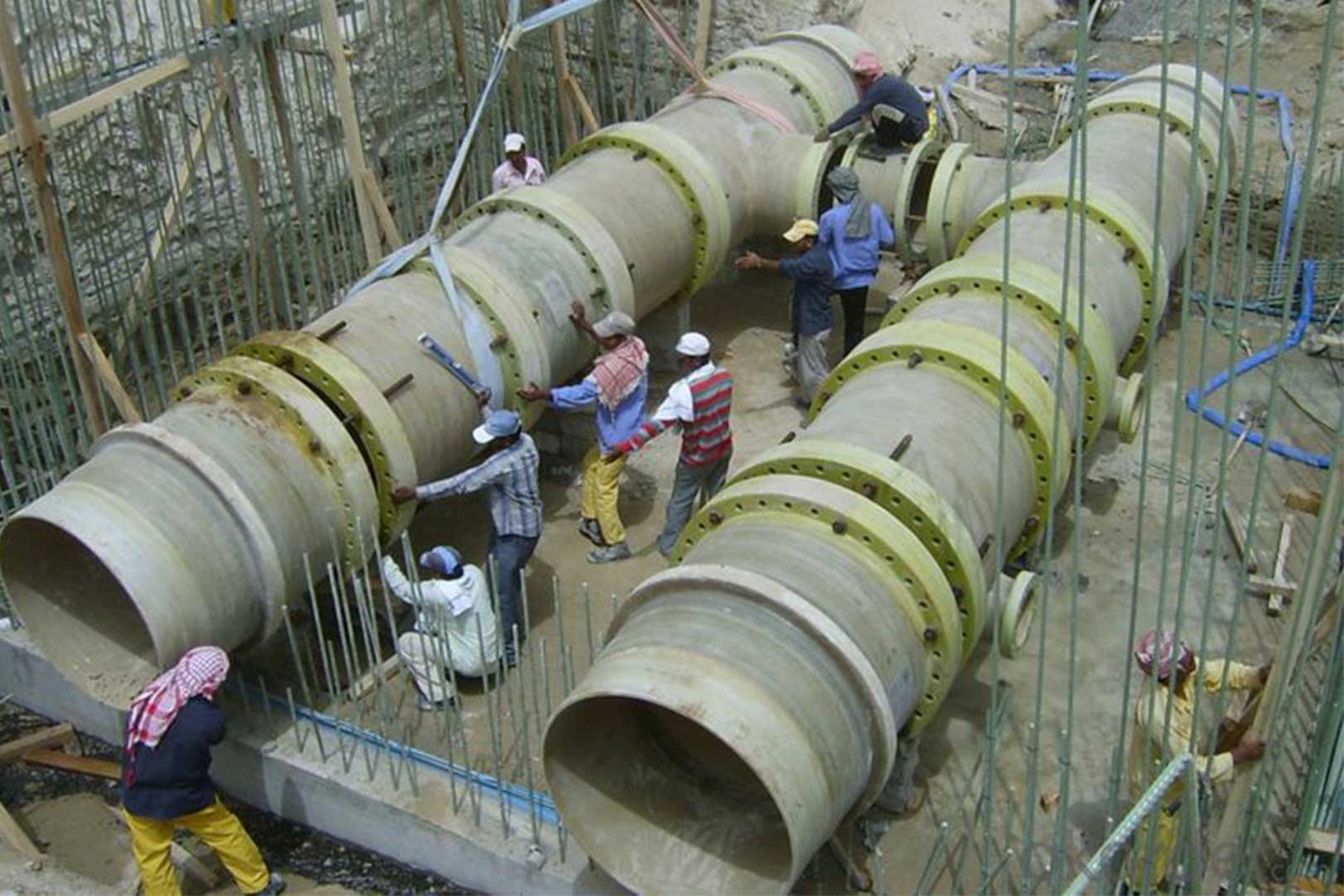
As time goes by, recent trends in piping systems are more likely to follow long-lasting and corrosion-free pipelines like composite pipes. Glass-reinforced plastic (GRP) pipes are made from glass fiber in a resin matrix via various methods to ease the piping way in water, wastewater, and chemical transmission systems.
Glass reinforced plastic (GRP) pipes are a composite combination of glass fibers in a resin matrix popular in water, wastewater, and industrial applications. Due to their corrosion resistance, durability, and lightweight nature, they ensure a stable and long-lasting piping system way more efficient than traditional pipelines like metal or PVC.
This article guides you to explore this cost-effective pipe through comprehensive aspects like manufacturing process, classification, applications, and other FRP pipes.
What Exactly Are GRP Pipes?
GRP pipes, also known as glass-reinforced plastic pipes, are such composite pipes manufactured via methods like filament winding or centrifugal casting.
Due to practical characteristics, this pipe is widely used in water and sewage management, oil, gas, and chemical transmission. Also, their non-corrosive nature made them the top choice for traditional piping system replacements, such as steel or concrete pipes.
Overview of GRP Pipes: Transforming Infrastructure Through Market Demand
Glass Reinforced Plastic (GRP) pipe’s lightweight nature made it superior in saving time and labor costs, while its corrosion resistance without coating and lining added reduced the need for maintenance and ensured a long lifespan in modern infrastructures.
The Growing Demand of GRP Pipes: exploring brand-new trends
As noted in MarketResearchFuture, the global market of GRP pipes was valued at USD 1.87 billion in 2024 and is expected to reach a growth at a CAGR of 4.2% from 2025 to 2030. This increase stems from recent trends of pipelines around the world demanding sustainable and eco-friendly pipelines that resist decades with no degradations.
The Strength of Glass Reinforced Plastic Pipes: Composition and Structural Design
The composite design and lightweight nature of GRP pipes come from glass fibers in a resin matrix, while shaping an exceptional performance in various applications.
In-Depth Explanation of Core Materials
Each of the brilliant GRP pipe components relies on these three central materials. Let’s dive into how glass fibers, resin base, and additives changed the game of piping systems:
Glass Fiber Reinforcement: Two major glass fiber types are used to increase the strength of the pipes: E-glass (electrical glass) and E-CR glass (Electrical/Corrosion Resistance Glass). E-CR glass is created to resist acidic and alkalic conditions better than E-glass (almost 20%).
Polyester and Vinyl Ester Resins: Resin matrix acts as a binder for the glass fibers (whether chopped or roving). Polyester resin, including half of the market, shines in potable water and sewage systems. However, vinyl ester resists chemical and harsh conditions 15–20% better with a temperature tolerance of 100°C.
Additives: Fillers and Stabilizers: To improve GRP pipes performance in aggressive environments, fillers like silica sand or calcium carbonate are added, and UV stabilizers avoid degradations in outdoor pipelines. Overall, these additives boost the lifespan by 50-100 years.

Why This Composition Enhances Durability and Strength
The combination of glass fiber and resin matrix shapes a complex pipe with durability and strength compared to traditional pipes like steel and PVC.
The high strength-to-weight ratio of GRP pipes compared with metal pipes and their corrosion resistance make them superior. Due to the customized resin matrix used in GRP pipes, they tolerate high chemical conditions and limited temperatures.
Manufacturing GRP Pipes: Processes and Techniques
The manufacturing process of GRP pipes involves four main methods: filament winding, which is the most popular, as well as centrifugal casting, hand lay-up, and pultrusion, all of which comply with international standards such as ASTM D3517 and ISO 14692.
1. Filament Winding (Continuous vs. Helical)
The most used method among GRP pipe manufacturing methods is filament winding, in which glass fibers are combined in a resin base and twisted onto a mandrel until they reach the desired strength and diameter. There are two techniques for filament winding: continuous and helical.
Continuous filament winding is winding the glass fibers continuously to achieve a smooth and uniform pattern that is ideally used in large-scale production lines for water or wastewater systems that require high diameter sizes.
Helical filament winding is used to adjust the hoop and axial strength needed in seismic zones and underground pipelines via winding fibers at different angles (e.g., 55°–85°) that create a tolerance of pressure up to 40 bar.
2. Centrifugal Casting
To build a smooth inner surface of GRP pipes, centrifugal casting with the addition of a resin-rich inner layer to the mold and again layers of fiber and resin are applied, reaching a uniform finish for potable water systems. This method is mainly used for medium to large manufacturing scales with smooth surfaces, increasing the flow efficiency.
3. Hand Lay-Up
To customize or manufacture the GRP pipes in small scales, use the hand lay-up method by applying resin-rich glass fiber mats to the mold manually to control the wall thickness. This method requires well-trained workers to create such flexible chemical processing plants where special fittings ensure high resistance against aggressive fluids.
4. Pultrusion for Specialized Designs
Pultrusion is a process to pull glass fiber through a resin bath to shape it into a sturdy pipe for specific applications like offshore platforms and industrial transmissions where cross-sections and rectangular tubes are required.
Impact of Manufacturing Process on Pipe Properties
The manufacturing process of GRP pipes affects their characteristics. For instance, filament winding improves pressure tolerance in high-pressure pipelines, while centrifugal casting increases the flow rate via smooth surfaces. Hand lay-up and pultrusion allow customization in pipes for chemical processing and marine conditions.
| Property | Filament Winding | Centrifugal Casting | Hand Lay-Up | Pultrusion |
|---|---|---|---|---|
| Key Features | Continuous or angled fiber winding, seamless | Smooth inner layer, rotating mold | Manual resin/fiber layering | Continuous profiles via resin/die |
| Applications | Water, sewage, oil/gas pipelines | Wastewater, potable water | Custom fittings | Offshore, cable protection |
| Strengths | Efficient, consistent, tailored strength | Smooth surface, high stiffness | Flexible design | High fiber content (70%) |
| Limitations | Cylindrical shapes, higher cost for helical | Medium/large diameters only | Labor-intensive, less scalable | Small, non-standard shapes |
| Impact on Properties | High tensile strength large diameters, high pressure | 15% less friction, strong for underground | Custom strength, quality varies | High strength, corrosion resistance |
Performance Excellence of GRP Pipes: Key Characteristics
The exceptional properties of GRP pipes make them show such a magnificent performance in water distribution and oil and gas pipelines. High strength-to-weight ratio, corrosion and chemical resistance, and thermal and pressure tolerance are those characteristics that indicate how GRP pipe shines in various use cases:
- Strength-to-Weight Ratio: GRP pipe reached a strength of 1,000–1,500 MPa, and steel pipe reached 500–600 MPa. (Source: ScienceDirect) This ratio can reduce the transportation and installation costs in underground pipelines and difficult-to-access areas like marine conditions.
- Resistance to Corrosion and Chemicals: Unlike metal pipe that needs to be covered by coating and lining to resist aggressive conditions, GRP pipes require no coverage and tolerate the corrosion in harsh soils and chemical fluids in offshore platforms or wastewater systems.
- Thermal Stability: Applying a vinyl ester or epoxy resin layer to the inner side allows GRP pipes to resist a wide range of temperatures, from -40°C to 110°C for epoxy-based pipes and up to 100°C for vinyl ester-based pipes.
- Surge Pressure Resistance and Longevity: In dynamic systems like water distribution and oil and gas pipelines, high-pressure resistance is the key factor. GRP pipes shine from hydraulic testing to tolerance over decades under high pressure, lasting way longer than steel pipes.
Classification of GRP Pipes: Customized Solutions for Diverse Applications
The FRP as an umbrella for the fiber-reinforced plastic pipes addresses these three central pipes, such as GRP, GRE, and GRV pipes, representing how they expand their solution in each application of piping systems.
GRP pipes: GRP pipes made from polyester resin are used in many sectors, including municipal water distribution, sewage systems, and irrigation networks, with smooth inner surfaces, resistant to temperatures below 80°C and pressures up to 25 bar.
GRE Pipes: According to Wermac, glass-reinforced epoxy pipes, due to the tolerance of temperatures up to 110°C and cross-sectional epoxy matrix, are used in dynamic systems like offshore platforms, oil and gas pipelines, and refinery systems.
GRV/GRVE Pipes: Glass-reinforced vinyl ester pipes are utilized in environments with aggressive chemicals, adding vinyl ester resins for superior chemical resistance in chemical processing plants, desalination facilities, and wastewater treatment systems.

Optimized Installation Techniques for GRP Pipes
The installation of GRP pipes includes different methods to ease the process in every type of application. Below, each aspect of installation, including transportation, common jointing systems, and installation methods, is explained:
Handling and Transporting of GRP Pipes
To prevent predictable damage, GRP pipes should be handled carefully with padded slings to avoid cracks. There are some hints and guidelines for manufacturers to aid them in transporting pipes with no breaks.
Transportation Tip: Unlike metal pipes, GRP pipes don’t require heavy machinery like cranes for transportation, while they may be handled in smaller sizes and joined later for breakage prevention.
Common Jointing Systems of GRP Pipes
To achieve a leak-proof pipeline, selecting the right method is the key. Here are multiple choices and their comparison:
- Double Bell Couplings: Mainly used for low to medium pressure in water distribution where quick installation matters.
- Flanged Joints: Designed for high-pressure applications like oil and gas or industrial systems where durable and permanent joints are needed.
- Adhesive Bonded Joints: They also create a permanent and high-strength connection via coated pipe ends with epoxy in desalination plants and chemical processing for handling aggressive fluids.
- Threaded/Mechanical Connections: Perfect for joining systems that require disassembly, like temporary pipelines or applications with regular maintenance, like irrigation.
| Joining Method | Features & Strengths | Applications | Limitations |
|---|---|---|---|
| Double Bell Couplings | Flexible seal with rubber gasket, 20% faster installation | Water, sewage systems | Limited to 16 bar |
| Flanged Joints | Bolted, leak-proof, strong connections | Oil/gas, high-pressure | Needs precise alignment |
| Adhesive Bonded Joints | Permanent, seamless, corrosion-resistant | Chemical processing, desalination | Less flexible, permanent |
| Threaded/Mechanical | Quick assembly/disassembly, threaded ends | Temporary, modular systems | Lower pressure (10 bar) |
Methods of Installation in GRP Pipes
Basically, installation methods of GRP pipes are divided into two main types: trenching and trenchless installation. However, trenchless methods include microtunneling or above-ground methods, which are clarified below:
Trenching starts with digging a trench and bedding the pipes carefully, providing proper coverage of resin for corrosion prevention. This is widely used for municipal water and sewage networks to handle soil pressure and traffic loads.
Above-ground installation involves UV-stabilized pipe handled with brackets or saddles to prevent any movement or crushing in chemical systems, power generation plants, and oil refineries.
Trenchless installation, such as microtunneling, decreases the cost of trenching and surface disruption for urban areas or sensitive sites like water mains or city sewage systems.
How Do Applications of GRP Pipes Vary Across Industries?
Due to specific characteristics of the GRP pipes, they are preferred in many applications such as water distribution and sewage systems or marine and offshore applications.
Water and Wastewater Management
GRP pipes are the top choice in delivering drinking water and managing wastewater due to their corrosion resistance and smooth inner surface that reduce the need for pumping and lining the surfaces.
Industrial Applications
Handling harsh fluids and high-pressure systems requires GRP pipes with vinyl ester resin to resist acids and alkalis, while epoxy-based pipes withstand pressures up to 40 bar and temperatures up to 110°C, perfect for oil and gas systems.
Power and Energy
Power plants like cooling lines critically use GRP pipes due to their lightweight and corrosion resistance, while GRV pipes shine in the Flue Gas Desulfurization (FGD) Systems, where durability and acid resistance matter the most.
Marine and Offshore
The lightweight nature and resistance to saltwater of GRP pipes make them perfect for offshore and marine conditions. For instance, GRV pipes handle saline water and aggressive chemicals in desalination plants, and GRP pipes are used in ballast systems for reduced weight compared to metal pipes. (Source: BSEE)
Agriculture
GRP pipes and GRV pipes with UV stabilizers added are shining in above-ground piping systems like irrigation plants. Also, their minimal maintenance and lightweight make them a top choice for rural water distribution systems.
GRP Pipes vs. Other Pipe Materials: A Comprehensive Comparison
GRP pipes are superior to traditional pipelines like steel, PVC, or ductile iron pipe where longevity was the key. This section explores how GRP pipes differ from their alternatives:
- GRP vs. Ductile Iron Pipes: They are both commonly used in water systems where high-pressure flows require such high strength, and GRP pipes, due to their corrosion resistance and cost-effectiveness, are perfect choices.
- GRP vs. GRE: The only difference is the resin matrix used; epoxy resin in GRE pipes usually shows flexibility and high temperature tolerance, while GRP pipes are cost-effective and more likely to resist under pressure.
- GRP vs. Steel: GRP pipes contain significant benefits over steel pipes in corrosion resistance, weight, and durability without maintenance in offshore platforms and aggressive environments.
- GRP vs. PVC/HDPE: GRP pipes compete with PVC and HDPE pipes in mechanical strength, long lifespan, and flexible design.
Economic and Environmental Benefits of GRP Pipes
GRP pipes provide such benefits over traditional alternatives like steel, ductile iron, and concrete pipes in water, wastewater, oil and gas, and industrial applications.
Cost Savings in Transport, Installation, and Maintenance
GRP pipes have a higher strength-to-weight ratio than metal pipes, reducing the cost of transportation and installation of heavy machinery like cranes. Also, the corrosion resistance of resin-based pipes avoids any cathodic protection or extra coatings.
Lifecycle Cost Benefits Over Traditional Materials
Traditional materials used to resist in harsh environments up to 40 years at best conditions, including regular maintenance and coating layers. While based on Amiblu, GRP pipes have a lifespan of 50–100 years, and this durability decreases the lifecycle costs 20–40%.
Sustainable Manufacturing and Recyclability of GRP Pipes
Through an accurate molding process, GRP pipes reduce the waste of material, and their carbon footprint is significantly lower than steel pipes. Their recyclability and leak-proof design minimize environmental impact, aligning with global sustainability goals.

Choosing GRP Pipes: Key Considerations for Optimal Performance
To select the right pipeline for your project, there are several considerations helping you meet the piping system’s special demands.
How to Select the Right Pipe Material: GRP, GRE, or GRV?
Depending on the project, the right pipelines between GRP, GRE, and GRV ensure a durable performance. GRP is perfect for general uses in water and sewage systems, GRP for high-pressure oil and gas pipelines, and GRV is an excellent choice for chemical processing where vinyl ester covers the inner surface.
Ideal Environments and Projects
GRP pipes are best suited for corrosive environments, high-pressure systems, and projects prioritizing sustainability, such as desalination plants, municipal water networks, and offshore platforms.
Design Guidelines and Expert Consultation
The consultation process with reliable manufacturers and designed guidelines and standards like AWWA or ISO shapes installation and after-sale service properly. Considerations include pipe stiffness, jointing systems, and environmental conditions to improve performance.
GrandPipeGroup: Your Trusted GRP Supplier
GrandPipeGroup is known as a leader in GRP, GRE, and GRV pipe manufacturing and supplying projects in more than 40 countries over 30 years.
GrandPipeGroup is your reliable partner in offering high-quality, innovative, and corrosion-resistant GRP, GRE, and GRV pipes in Kenya, Ethiopia, Tanzania, Uganda, Rwanda, Oman, UAE, and Qatar.
Contact us today to elevate your project with professional and sustainable piping solutions!
Conclusion
GRP pipes, with their corrosion resistance, lightweight design, and durability, are transforming infrastructure in 2025. Due to their cost-effective, sustainable solutions, they are perfect choices for water, wastewater, oil, gas, and industrial applications, and they compete with traditional materials like steel and PVC. With an expected market growth of 4.2% CAGR through 2030, GRP pipes ensure long-lasting, eco-friendly performance, making them the top choice for modern piping systems.
FAQs
1- What are GRP pipes?
GRP pipes are also known as glass reinforced plastic pipes are such composite pipes manufactured via methods like filament winding or centrifugal casting.
2- What materials make up GRP pipes?
Each brilliant GRP pipe component relies on these three central materials: glass fiber reinforcement, polyester or vinyl ester resins, and additives like silica sand or UV stabilizers.
3- How are GRP pipes classified?
The FRP as an umbrella for the Fiber reinforced Plastic pipes addresses these three central pipes such as GRP, GRE, and GRV pipes to represent how they expand their solution in each application of piping systems.
about
The Author
Farshid Tavakoli is a seasoned professional in engineering and international trade. Holding degrees in Electrical Engineering, Mechatronics, and a Doctorate in Business Administration (DBA) from the University of Lyon, he also has a strong background in industrial automation and production line technologies.
For over 17 years, he has led an international trading company, gaining deep expertise in commercial solutions tailored to industrial needs. With more than 8 years of active involvement in infrastructure development, he specializes in the supply of electromechanical equipment for water and wastewater treatment plants and transfer projects.
Together with comapny expert team, he now provides consultancy and integrated solutions for sourcing and implementing complex infrastructure projects across the region.




